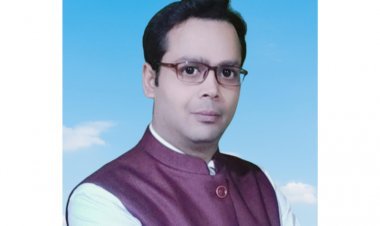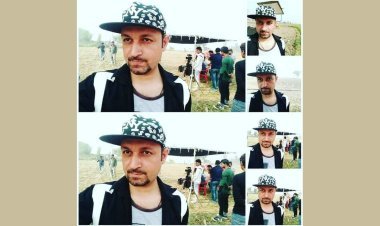Falling In and Out: A Gripping Journey Through Time, Choices, and Fate – Life’s Greatest ‘What Ifs’ Await You By Author Nishant Prakash

- What inspired you to write this particular book, and how did the idea for the story come to you?
I’ve always been a fan of speculative fiction and time travel stories. The inherent complexity of storytelling under such contexts is what makes this genre so appealing to readers and writers alike. But be it the lighthearted situations in a ‘Groundhog Day’ (the 1993 Classic) or the tumultuous predicament of the core characters in a ‘Dark’ (the Netflix blockbuster), what sets these stories apart is the basic human emotions that come to the fore under scenarios that normal human beings like you and me would have never been exposed to. How do you make the readers relate to such speculative scenarios? How do you make them feel for these characters? Those are just some of the questions that for me, as a writer, acted as a motivation behind piecing my story together.
- Can you share some insights into your writing process? Do you follow a specific routine or have any unique rituals that help you get into the creative flow?
I see writing as a means to relax my brain cells, focusing them on something that truly takes my mind off material things, and my thoughts away from the world and happenings around me. In many ways, it truly lets my mind wander into a world that is mine to create. I like studying people and observing situations around me, and then pondering over the ‘Why’s behind them. I believe this knack of keenly observing things, before I open my mouth or interject, is something that has helped me as a writer as well. I honestly believe that you need a certain level of research for penning down any relevant piece of literature – in my case, a large portion of this research comes from observing people and situations around me.
- The characters in your book are quite distinct and memorable. Are they based on real people, or did they evolve purely from your imagination?
While none of the characters in my book are based on real people, some of the situations that they face and their respective reactions are inspired by real life situations that I’ve observed throughout my life. For example – the book alludes to the growing communal and caste-based sentiments in the India of the 90’s and early 2000’s, and how it changed the mental makeup of some of the most rational human beings you knew around you. Most of the other character traits and details are based on careful persona detailing done at the start of the book, the journeys that each of the characters takes after this.
- Your book delves into how contemporary issues shape individuals. What motivated you to explore this theme, and what messages or discussions do you hope readers will take away from your work?
In a world where most of us tend to look at things and people as Black or White, only a few dare to look beyond this façade and realize that everything and every person around them are actually different shades of grey. The degree of this greyness is often defined by the situations and circumstances that each individual goes through, and how these changed their perspectives of themselves, others and the world around them. If only more people get to realize this, they might get better equipped at dealing with their surroundings and understand each other’s perspectives. While the central theme of the novel is around time travel, it is this innate understanding of human conditioning that is core to its build up.
- The world-building in your novel is incredibly rich and immersive. How did you go about creating the setting, and did you draw inspiration from any real-world locations or historical events?
Much like the situations these characters go through, that have been borrowed from real / contemporary ones, many of the locations and events covered in the book are also inspired by real locations and events. The only complexity here was figuring out how these might change as the characters travel through multiple realities and timelines, especially when they aren’t the only moving pieces in these universes.
- As a writer, how do you balance the need for originality with the expectations of the genre? Were there any challenges in putting your unique spin on familiar elements?
For me, originality comes from the way a story is told, the execution and the varied perspectives and elements it is able to bring together, that might not have been tried in the past, when a similar idea was laid out. The biggest challenge that I faced was around the running commentaries on contemporary issues in the book that may or may not have appealed to the mass public opinion – as a writer you have to be aware of these, choose the ones that are necessary for storytelling, and then stick to your guns in terms of not letting external opinion drive your narrative. It’s easier said than done, or so I realized during the 2 rounds of extensive editing that my book had to go through. But what makes this effort worthwhile is knowing that the outcome is something that you know is essential to the core story of the book – anything else could potentially be a distraction.
- The pacing of the story is well-crafted, keeping readers engaged from start to finish. Can you share your approach to maintaining tension and momentum throughout the narrative?
When I first shared my book with a group of beta readers, some of their initial reactions were that the book lacked pace to start with, but gradually, as they read through the entire manuscript, the common consensus was that there was a need to have a dual pace while telling this story – the first part of the book is more detailed and nuanced, as it helps the readers really get to know these characters and appreciate their choices; once this is established, the second part is naturally more pacey, building up the right oomph and thrill to the story that this genre demands. There is a risk here that many hardcore readers of this genre might decide to take a pause before the start of Part 2, but for those that decide to stick through, the payoff in the second half and the ending will be worth the buildup.
- In the age of rapidly changing media and reader preferences, how do you see the role of traditional storytelling evolving, and how do you adapt your writing to connect with contemporary audiences?
There’s a reason why more novels like ‘Falling In & Out’ are coming out in 2024 and not back in 2004 – the changing media and reader preferences have given opportunity to more forms of alternative story telling that would not have had the appeal in the decades gone by. While I still believe that a good story would always stand out regardless of which year or what era it comes out in, one cannot turn a blind eye to the changing demands of readers and audiences, who ultimately decide the fate of a book. At its core, storytelling is about connecting with human emotions, values, and experiences—an aspect that technology or trends cannot replace. However, how stories are told and consumed has evolved, demanding writers to adapt. And the way you adapt is by:
- a) bringing in more contemporary issues,
- b) making your characters more diverse and the themes more relevant to these contemporary issues,
- c) from a pure selling perspective, leveraging multiple platforms and formats to be able to reach the right audience who would be appreciative of such themes.
Grab your copy today on amazon and step into a world where every second counts!

 SRS Media
SRS Media 
















